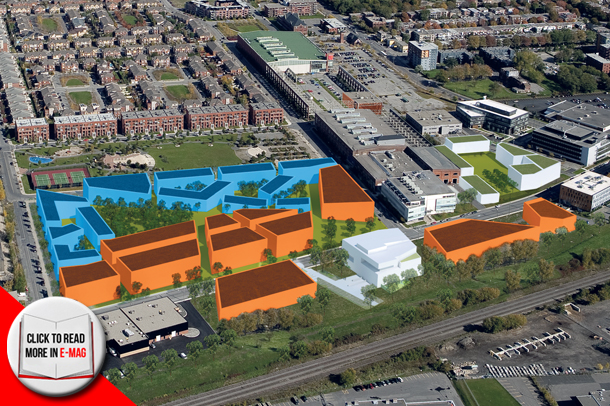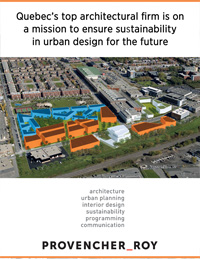By Leah Kellar
Provencher Roy & Associates is a dominant player in the urban architecture scene in Canada since 1984. The multidisciplinary firm offering services in architecture, architectural planning, urban planning, interior design and sustainable development has received more than sixty awards and honourable mentions in Quebec, Canada and internationally. Provencher Roy recently received the 2014 Urban Architecture Award from the Royal Architectural Institute of Canada (RAIC), which recognizes individuals, organizations, firms and projects that have contributed to the quality of life in Canadian cities through sustainable initiatives.
While it is great to receive the recognition that propels sustainable urban design planning forward, putting values of preservation of the environment and smart investment in the urban landscape together with practical implementation is a task that is best left to the experts such as Sylvain Gariepy, urban planner and partner in the firm since 2011. Gariepy has worked on major urban design projects across Montreal and Quebec. He established Provencher Roy Urbanisme, an affiliate of Provencher Roy & Associates, which expanded the range of planning services offered by the firm with specific concentration on insuring future regulatory compliance with sustainability initiatives. The firm is working with municipalities to produce local master plans for specific areas in the cities and with private developers to plan their real estate development projects. This involves working with local legislation and regulations including zoning by-laws to introduce and implement new standards and criteria to improve the long-term sustainability of the urban set up.
With all the talk of smart sustainable cities these days, Gariepy’s and the team at Provencher Roy & Associate’s task is harder than one might imagine. It is often a matter of integrating sustainable action into the municipal regulations that already exist in a city, such as a zoning by-law or other by-laws.
“It’s important to ask for more in terms of sustainable initiatives, not just wishes, but when you put that into the local regulation, then it becomes something that any developer must respect throughout their projects for years to come,” said Gariepy. “The main challenge for us is to take sustainable development initiatives and translate that into existing or new regulation, that is standards that developers will have to follow. But it’s a more proactive process that brings a positive contribution, instead of just being reactionary to policies and regulations.”
Provencher Roy is increasingly involved as a firm in architectural and urban planning projects for cities that incorporate sustainability initiatives and actually creating a new set of services for architects and helping to anticipate any issues in advance that may arise from the implementation of the local legislation or regulation. This process takes time, and understandably so, says Gariepy.
Just to get social acceptability for these urban planning initiatives by public authorities can be a challenge in and of itself.
“Even though it may seem that people want more sustainable planning and projects which are not standard, integrate new systems and will have an impact on existing public structures, you have to expect resistance from, for example, the Public Works Department or the Engineering Department, because they are used to doing things a certain way,” said Gariepy. “It’s hard to align everything properly at one point in time, but it’s all part of the negotiation process.”
He notes that this is one of the biggest concepts of young inspired new architects and planners to understand who have perhaps travelled extensively and are familiar with a variety of new aesthetically-pleasing structures and infrastructure that incorporate sustainable initiatives through planning and design concepts. The challenge for Provencher Roy is to make them aware of the applicable planning tools, such as knowing the zoning by-laws of a municipality and then work with them to evolve existing standards to reflect these new and exciting sustainable initiatives.
One milestone project for Provencher Roy that incorporates sustainable planning and design slated for completion in the next 10 years is the sustainable development of the Technopôle Angus. The Société de développement Angus (Angus Development Society) retained the services of Provencher Roy last year to complete its Technopôle Angus sustainable development plan for its central section and surrounding properties, which is flexible in order to allow buildings of different sizes to meet various requirements and needs expressed by businesses. The objective is to consolidate the employment sector within a diversified, vibrant, sustainable environment and thereby re-attach this isolated area to the surrounding urban fabric. The fundamental sustainability principles guiding the project are a quality environment, a permeable urban fabric and a diversity of uses, and the integration of attractive public spaces. The plan represents the roadmap for the next 10 or so years by which Angus will continue to develop and regenerate itself for the future.
“Hopefully someday it becomes a reference for integrating new ways of doing things such as how can we manage rainwater better, or how can we make sure that we are creating a mixed use environment where you will have offices as well as the residential component, that also integrates new technologies such as sustainable energy saving methods such as using the energy created on daytime by the offices to support the residential activities in the evening” said Gariepy. “It’s a very challenging process so we are looking at multiple approaches at this stage.”
He notes that the concept of ‘smart cities’ are really catching on in the mainstream consciousness, but putting those concepts into concrete initiatives is the challenge for Provencher Roy. Recently he took a trip to see how some Scandinavian firms tackle sustainability projects. One point he notes is that while Canada and Scandinavia have many good ideas and projects, Europe (in his opinion) seems to be far better on average at promoting their developments.
“One of the things we saw is that we do have good examples of best practices throughout Canada, Quebec, the United States, but we may not be as good as other countries to promote these good examples. Europe has a lot of success, partly because they are good at promoting their story,” he said.
He believes the North American market must develop its own inspiration out of Europe’s example and more importantly promote their own existing projects and best practices. Firms do take inspiration from what is seen over in Europe and bring new ideas to the Canadian market, but Gariepy really stresses that they should be doing a great deal more to promote their own good examples.
That’s just what Provencher Roy aims to do in its negotiation process within communities that want more sustainable infrastructure and green spaces, and also business developers. What has set the Provencher Roy apart from many firms in North America and Europe however is its urban planning and designing of mixed use spaces that incorporate office industrial space with residential space such as in the case of the Angus development. You can expect to see more of this pioneering effort in sustainability initiatives from Provencher Roy & Associates with a smart approach that is sure to last with legislative, regulatory backing for future generations to enjoy.







